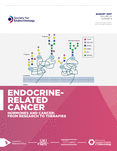BRCA2 functions: from DNA repair to replication fork stabilization
- 1Laval University Cancer Research Center, CHU de Québec Research Center - Université Laval, Hôtel-Dieu de Québec, Oncology Axis, Quebec City, Canada
- 2Lady Davis Institute for Medical Research, Segal Cancer Centre, Jewish General Hospital, Montreal, Canada
- 3Department of Oncology, McGill University, Montreal, Canada
- Correspondence should be addressed to A Orthwein or A Fradet-Turcotte; Email: alexandre.orthwein{at}mcgill.ca or Amelie.Fradet-Turcotte{at}crchudequebec.ulaval.ca
Abstract
Maintaining genomic integrity is essential to preserve normal cellular physiology and to prevent the emergence of several human pathologies including cancer. The breast cancer susceptibility gene 2 (BRCA2, also known as the Fanconi anemia (FA) complementation group D1 (FANCD1)) is a potent tumor suppressor that has been extensively studied in DNA double-stranded break (DSB) repair by homologous recombination (HR). However, BRCA2 participates in numerous other processes central to maintaining genome stability, including DNA replication, telomere homeostasis and cell cycle progression. Consequently, inherited mutations in BRCA2 are associated with an increased risk of breast, ovarian and pancreatic cancers. Furthermore, bi-allelic mutations in BRCA2 are linked to FA, a rare chromosome instability syndrome characterized by aplastic anemia in children as well as susceptibility to leukemia and cancer. Here, we discuss the recent developments underlying the functions of BRCA2 in the maintenance of genomic integrity. The current model places BRCA2 as a central regulator of genome stability by repairing DSBs and limiting replication stress. These findings have direct implications for the development of novel anticancer therapeutic approaches.
- BRCA2
- homologous recombination
- replication stress
- DNA double-stranded break repair
- genomic stability
- Fanconi anemia
- DNA replication
- cancer therapy
- Received 13 August 2016
- Accepted 16 August 2016
- Made available online as an Accepted Preprint 16 August 2016
- © 2016 Society for Endocrinology












